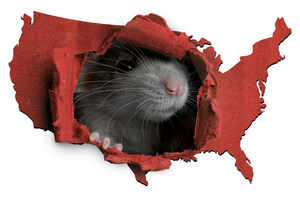Washington, D.C. Surpasses Baltimore to Secure Top Spot on Orkin's 2020 Bed Bug Cities List
After three consecutive years as the #1 city, Baltimore drops to second place and Indianapolis breaks into the top 10
ATLANTA, Jan. 13, 2020 /PRNewswire/ -- Washington, D.C. is ringing in the new decade as the number one city on Orkin's Top 50 Bed Bug Cities list. Meanwhile, Baltimore fell to the second spot after three years as the frontrunner, and Indianapolis joined the top of the list.
Flint saw the biggest jump moving 16 spots to number 31 after only joining the list in 2018. Pittsburgh and Champaign both broke into the top 20, and Myrtle Beach and Toledo joined the top 50 list for the first time.
The list is based on treatment data from the metro areas where Orkin performed the most bed bug treatments from December 1, 2018 – November 30, 2019. The ranking includes both residential and commercial treatments.
- Washington, D.C. (+1)
- Baltimore (-1)
- Chicago
- Los Angeles
- Columbus, OH
- New York
- Detroit (+1)
- Cincinnati (-1)
- Indianapolis (+5)
- Atlanta (-1)
- Cleveland, OH
- Philadelphia (-2)
- San Francisco (-1)
- Raleigh, NC (-1)
- Norfolk (+2)
- Champaign, IL (+7)
- Dallas (-2)
- Grand Rapids (+2)
- Pittsburgh (+6)
- Charlotte (-1)
- Richmond, VA (-5)
- Greenville, SC (-4)
- Knoxville, TN (-1)
- Buffalo, NY (-3)
- Greensboro, NC (-4)
- Charleston, WV (+5)
- Denver
- St. Louis (+2)
- Nashville (-5)
- Lansing (+2)
- Flint (+16)
- Miami (-3)
- Milwaukee (-3)
- Tampa (+1)
- Omaha (+2)
- Orlando (+5)
- Davenport, IA (+5)
- Houston (-12)
- Syracuse (-6)
- Boston (-2)
- Cedar Rapids, IA (+3)
- Myrtle Beach (new to list)
- Seattle (-4)
- San Diego (+5)
- Phoenix (-11)
- Fort Wayne, IN (+2)
- Las Vegas (-7)
- Hartford, CT (-5)
- Dayton, OH (-3)
- Toledo, OH (new to list)
"While bed bugs have not been found to transmit any diseases to humans, they can be an elusive threat to households," said Chelle Hartzer, an Orkin entomologist. "They are excellent hitchhikers, and they reproduce quickly which make it nearly impossible to prevent bed bugs. Sanitation has nothing to do with where you'll find them."
Bed bugs, which are typically 4-5 mm in length and red to dark brown in color, can travel from place to place with ease, including luggage, purses and other belongings. Normally nocturnal, bed bugs will come out of hiding to take blood meals from sleeping or quietly resting humans.
According to the 2018 "Bugs without Borders Survey" by the National Pest Management Association (NPMA), the top three places where pest professionals report finding bed bugs are single-family homes (91 percent), apartments/condominiums (89 percent) and hotels/motels (68 percent). With that, hotels spend an average of $6,383 per bed bug incident¹.
Bed bugs are known for rapid population growth. Females can deposit one to five eggs a day and may lay 200 to 500 eggs in their lifetime. Under normal room temperatures and with an adequate food supply, they can live for more than 300 days, often making treatment challenging.
"The key to preventing a bed bug infestation is early detection," Hartzer said. "When one or more bed bugs enter a space, we call it an introduction. During an introduction, bed bugs probably haven't started reproducing yet, but they could soon. Vigilance is key to stopping bed bugs before infestation levels."
Tell-tale signs of a bed bug introduction could include small black spots indicating bed bug feces or nymph bed bugs in places such as mattress seams, bed frames and furniture. Their small size and ability to hide make them difficult to see during the day, so it's important to look for the black, ink-like stains they can leave behind.
Here are proactive tips Orkin recommends for homeowners and travelers:
At Home:
- Inspect your home for signs of bed bugs regularly. Check the places where bed bugs hide during the day, including mattress tags and seams, and behind baseboards, headboards, electrical outlets and picture frames.
- Decrease clutter around your home to make it easier to spot bed bugs on your own or during professional inspections.
- Inspect your residence regularly—when you move-in, after a trip, when a service worker visits or after guests stay overnight.
- Examine all secondhand furniture before bringing it inside your home. This is a common way for bed bugs to be introduced into homes.
- Wash and dry your bed linens often, using the hottest temperature allowed for the fabric.
During travel, remember the acronym S.L.E.E.P. to inspect for bed bugs:
- Survey the hotel room for signs of an infestation. Be on the lookout for tiny, ink-colored stains on mattress seams, in soft furniture and behind headboards.
- Lift and look in bed bug hiding spots: the mattress, box spring and other furniture, as well as behind baseboards, pictures and even torn wallpaper.
- Elevate luggage away from the bed and wall. The safest places are in the bathroom or on counters.
- Examine your luggage carefully while repacking and once you return home from a trip. Always store luggage away from the bed.
- Place all dryer-safe clothing from your luggage in the dryer for at least 15 minutes at the highest setting after you return home.
For more information about bed bug prevention, visit Orkin.com. You can also find 100 facts about bed bugs in Orkin's bed bug e-book: "100 Reasons Why Bed Bugs Are Freaky – and Fascinating" and additional detection tips in Orkin's video on "How to Check for Bed Bugs in Hotel Rooms."
About Orkin, LLC
Founded in 1901, Atlanta-based Orkin is an industry leader in essential pest control services and protection against termite damage, rodents and insects. The company operates more than 400 locations with almost 8,000 employees. Using a proprietary, three-step approach, Orkin provides customized services to approximately 1.7 million homeowners and businesses in the United States, Canada, Mexico, Europe, South America, Central America, the Middle East, the Caribbean, Asia, the Mediterranean and Africa. Orkin is committed to studying pest biology and applying scientifically proven methods. The company collaborates with the Centers for Disease Control and Prevention (CDC) and eight major universities to conduct research and help educate consumers and businesses on pest-related health threats. Learn more about Orkin at Orkin.com. Orkin is a wholly-owned subsidiary of Rollins Inc. (NYSE: ROL). Follow us on Facebook and LinkedIn.
¹According to Orkin's Behind the Cost of Bed Bugs Hospitality Industry Report (in partnership with The Bantam Group).
SOURCE Orkin, LLC

Related Links
WANT YOUR COMPANY'S NEWS FEATURED ON PRNEWSWIRE.COM?
Newsrooms &
Influencers
Digital Media
Outlets
Journalists
Opted In





Share this article